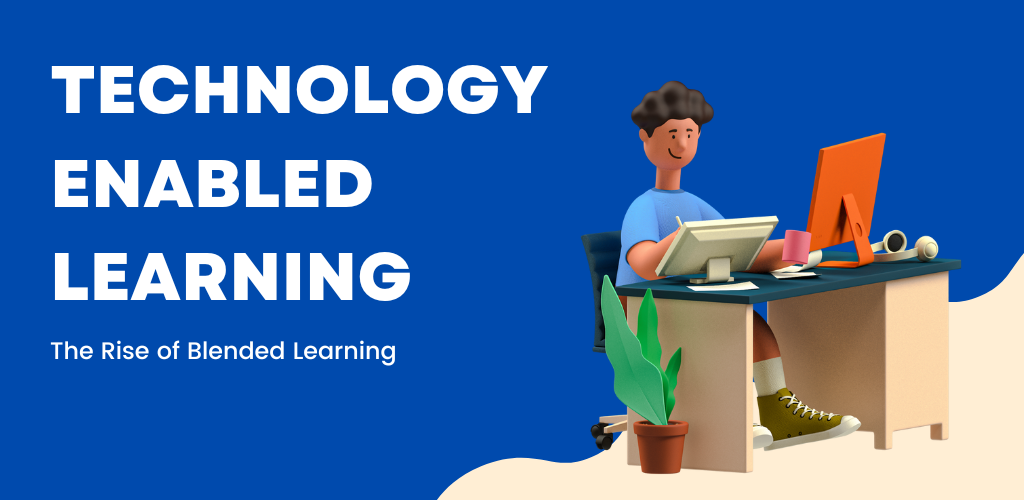To thrive in the real world, technology is essential. Technology in education does not necessarily mean that teachers will be replaced by it. Teaching is one of the occupations that are least likely to be automated. However, when used as a tool to improve learning, technology has the potential to change how students and teachers interact and improve the experience of learning (and teaching).

Technology Enabled Learning (TEL) describes the use of technology, networks, systems, and digital content indented to extend, enhance student-centered learning, and promote education. With the introduction of The Sandbox in 1806 or revolutionary new technologies like the 16-millimeter movie projector or the personal computer, TEL has long aided education, especially higher education. In reality, however, technology remained very much a supporting tool in conventional classrooms despite these advancements.
Technology has so far been employed in educational institutions primarily to support established methods of teaching and learning. But the present-day educational system needs education that puts expertise to use, assesses it, generates new knowledge, and consolidates it. Recent research has demonstrated that rather than being utilized for monotonous "drill and kill" exercises, technology is most effective when it is interactive, provides real-time feedback, and enables students to creatively apply and assess what they have learned.
For a plethora of reasons, technology-enhanced learning is pivotal. It is significant not solely because it surpasses the current norms for quality education, but also because it has the potential to raise standards. Beyond all recognition, TEL is improving and revolutionizing the educational system. In light of this, it cannot be disregarded!
A new era in education is emerging, one in which technology plays a vital role in enhancing the learning environment for both students and teachers. Nowadays, students are more tech-savvy than ever before, and they interact with technology frequently throughout the day. The National Education Policy also places a strong emphasis on gaining technology-based 21st-century skills. According to studies, if the education system continues on its current trajectory, by 2030, half of all children and young people worldwide will lack the fundamental secondary-level abilities needed to thrive. As a result, the education system requires what the Center for Universal Education (CUE) refers to as leapfrogging—rapid, non-linear progress.
The effective use of TEL can support this rapid development, and remove obstacles to teaching and learning, as well as those related to space and time, leading to lifelong learning. TEL can provide strategies and resources to help professors and students in higher education deal with issues. Teachers will have better tools at their disposal to interact with students, manage the classroom better, and invest less time in devising lesson plans. Students, on the other hand, will feel motivated, empowered, and confident about the course they will be pursuing.
In order to better facilitate interaction, engagement, and understanding in their classrooms and lecture halls, educators can utilize this booming tech in the following ways:
The Rise of Blended Learning
According to Rovai and Jordan, 2004, Blended Learning is “A hybrid of classroom and online learning that includes the conveniences of online interaction without the complete loss of face-to-face contact.” So if one asks about the strengths of Blended learning then they can be stated as:
1. Control over the curriculum design, content delivery, and evaluation.
2. Leverages external enterprise.
3. Virtual teaching collaborator.
4. Flexible for both students and faculty as it removes restrictions on time and pace.
5. Improved pedagogy; i.e. personal engagement experience for the student and feedback.
6. Improved access to course material.
7. Opportunities to collaborate and coevolve.
8. Resource Magnifying.
9. Fills Faculty skill gaps; Learning for the teacher.
10. Matches broader trends in technology and society.
Today students and teachers seem to be more reliant than ever on technology to assist them to overcome the physical distance as a result of blended and hybrid learning. It's likely that Technology Enhanced Learning will be the key impetus behind refining these methods of instruction as blended learning develops.
Students Can Advance At Their Own Pace
We are aware of the fact that each child learns at a different rate, which can occasionally be challenging in a traditional classroom environment. With the advancement of technology in education, children can adjust their learning pace. Students who require more time can spend longer going over the exercises until they fully grasp them, while students who require less assistance can go on. Furthermore, it allows the teacher additional time to provide individualized assistance to those who require it.
Many online and offline applications and software will eliminate the need for students to signal their problems keeping up with their classmates—something which many find embarrassing, especially if this entails the classic hand-raising method—which can be done in a variety of ways. In the same way, students who desire a greater challenge can continue to exert themselves and utilize their time more effectively.
Improved Access To Resources
With TEL, teachers are no longer restricted to the textbooks that are provided by their institutions. Students have a wide range of learning options by utilizing additional materials like videos, podcasts, case studies, discussion forums, social media platforms, LMS, websites, e-books, and interactive learning. Teachers can also come up with innovative strategies to engage their class. This learning environment has evolved due to technology, making it more interactive.
Everywhere on the internet, there is now access to a deeper pool of materials due to online resources for subject experts and other teachers. Additionally, numerous online forums and discussion boards will cover how to use particular tools and software in the classroom effectively so that there are fewer technical issues and protracted break-in periods.
Students Are Captivated By Technology
Children frequently find it difficult to stay engaged or on task, especially if it is not engaging. TEL can add interest to even the most monotonous schoolwork, which will retain the student's attention. This is especially poignant when we take into account the prior statement about how prevalent and accepted technology is among today's young children.
Children are surrounded by technology from an early age and are most comfortable using it. In order to keep the students engaged, several ed-tech businesses are emphasizing the concepts of gamification and interactivity. Students are more likely to appreciate the experience and remember the content being taught when they are more engaged.
To thrive in the real world, technology is essential. Technology in education does not necessarily mean that teachers will be replaced by it. Teaching is one of the occupations that are least likely to be automated. However, when used as a tool to improve learning, technology has the potential to change how students and teachers interact and improve the experience of learning (and teaching). Teachers all over the world will be able to make better teaching decisions for their own learning and the learning outcomes of their students owing to the use of technology.

.png)